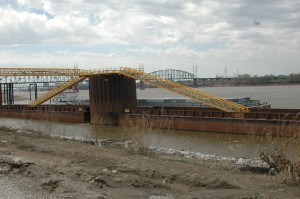Granite City repositions to renew economy
Chronicle Media — June 4, 2015
A mechanical loading arm, used to transfer cargo containers to and from Mississippi River barges during an April demonstration at the America’s Central Port facility in Madison County, could help make the Granite City area a major transportation hub and develop the nation’s inland waterways as a freight shipping network, planners say.
Local officials are breathing a sigh of relief this week after United States Steel Corporation announced it will keep its Granite City Works open, avoiding the layoff of 2,000 workers. However, in an aging Rust Belt town with a history of plant shutdowns and labor cutbacks, the prospect of future layoffs and closings remains ever-present.
However, Granite City has adopted a “new outlook” regarding business over recent years, says Mayor Hagnauer.
The city this month begins putting the finishing touches on a new Granite City Economic Development Strategic Action Plan. A new Economic Development Commission is being established.
The Business Expansion, Attraction and Retention (BEAR) program, instituted by Hagnauer after he was first elected mayor in 2006, has amassed a solid record of achievement, according Jonathan Ferry, the city’s economic development director. Ferry, a Granite City native with a master’s degree in economics and finance, was brought in as economic development director in 2006, after the post remained vacant for four years.
“Over the past eight years, the city has spent considerable time and effort investing in our existing businesses,” Ferry said of the BEAR program. Since the start of the Great Recession, Granite City businesses have invested a total of $951 million in expansion projects – with at least 34 projects over $1 million – resulting in 626 new,full-time, permanent jobs. Some 4,510 jobs have been retained.
“Manufacturing jobs have recovered to pre-recession levels” in Granite City, Ferry notes.
Drawing perhaps the most attention has been the $40 million expansion of the city’s Kraft Foods manufacturing plant. The 660,000-square-foot facility already has about 410 workers. It will now have 30 more, manning four new production lines. The expansion is to be completed in the coming weeks.
Granite City and the Illinois Department of Transportation provided about $400,000 to widen Missouri Avenue in front of the plant to accommodate increased truck traffic.
Still, largely under wraps, are plans for a new Route 3 industrial park.
“There is a large industrial land developer who has placed the proposed development site under contract,” Ferry said. “They are working on their initial engineering plans and doing due diligence, currently. The plan for the park is to develop a space for future big box distribution facilities along with manufacturing operations.”
Nearby, the America’s Central Port complex continues to expand, developing barge-to-rail transfer capabilities for freight containers. Some industry experts believe rising fuel prices will spur development of container-on-barge networks on major inland waterways over the coming years.
The 1200-acre complex already serves as a barge, rail, and truck freight hub for over 70 tenants and operating companies, employing over 750 people on its property. The complex also includes southwest Illinois’ only small business incubator, the River’s Edge. The mayors of Granite City, Madison and Venice set on the port board.
Downtown, the unique, city-owned Granite City Cinema has helped attract over a dozen new restaurants and small shops to a new entertainment district. The upscale theater was built in 2010 with $4.6 million in tax increment financing.
However, retail growth, property values, incomes, and poverty rates remain among the region’s worst. Only 19% of Granite City’s workers live there.
“People who have the income to choose where they live are not choosing Granite City,” Ferry said
An important aspect of the economic development plan will be flexibility, Ferry notes.
The plan will call for “an iterative approach to accomplishing strategic initiatives. By that, what we mean is that while the big picture goals are set within the plan, the process of getting there will be done in phases of planning and implementing that are at times only 30 days long. That way, instead of trying to plan out every step of the process for the next five or ten years, the implementation of the plan can be more flexible and responsive to changes that might occur that are currently unforeseen,” Ferry said.
Critical to its success will be extensive public participation, Ferry emphasizes. A steering committee of city council and economic development commission members met extensively with business people and residents over the past six months to get public input on the plan. Committee members are now trying to establish a network of interested citizens to facilitate implementation.



